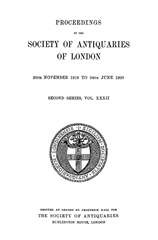No CrossRef data available.
Article contents
Thursday, 8th March 1917
Published online by Cambridge University Press: 10 May 2010
Abstract

- Type
- Proceedings
- Information
- Copyright
- Copyright © The Society of Antiquaries of London 1917
References
page 114 note 1 It is due to the skill of Mr. Augustus Ready that I am able to reproduce the inscription on the hoop, as well as on the bezel, from plaster casts.
page 115 note 1 Ducange has ‘V pro O scriptum frequenter ab antiquis librariis monet idem Baluzius in Notis ad Capitul. col. 990, quod ex corrupta enunciatione factum esse existimo’.
page 115 note 2 A. M. Hind, Br. Mus. Catal. of Ital. Engr., p. 317, no. 21.
page 115 note 3 Birch, Br. Mus. Catal. of Seals, no. 22, 212.
page 115 note 4 Dalton, Br. Mus. Catal. of Rings, nos. 231 and 261.
page 115 note 5 It must not be forgotten, however, that this phenomenon is found in other Italian islands, and also in Liguria, so that Ascoli speaks of it as ‘fenomeno insulare per eccellenza, il quale collega la Corsica con la Sardegna e con la Sicilia, ma pur con la Liguria’ (Archiv. Glottol. Ital. viii, pp. 111–12). There are also considerable traces of it in the Neapolitan district.
page 116 note 1 Acta Sanctorum, Boll., V Febr., p. 623; Sarum Breviary (Cambridge ed.), vol. iii, p. 159. The story is also given in the Capuan Breviary, according to Carrera. Both forms spontaneam and spontaneum occur in the MSS. of the Acts, but the former is far the commoner in all later versions of the story. See below.
page 116 note 2 Memorie historiche di Catania (1641).
page 116 note 3 Carrera, ii, pp. 422–3.
page 116 note 4 Manini, L., Mem. stor. di Cremona, 1819–20, ii, p. 109.Google Scholar
page 117 note 1 It is noticeable that either because the translation of the Latin was difficult, or, more likely, because special virtue resided in the original wording, the formula is not translated into English in such a popular work as Caxton's Golden Legend. It is, however, in the early South-English Legendary edited by Horstmann (E. E. T. S. 1887, p. 197, vv. 117, 118) : ‘þis Maide hadde holi þouзt: god heo dude honour, | A-served heo hath to alle þe contreie : deliueraunce of langour.’
page 117 note 2 Allard, in Cabrol, Dict. d'Arch. Chrét., i, p. 850.
page 117 note 3 Brand's, Popular Antiquities (1893), iii, p. 271Google Scholar, quoting from ‘The Burnynge of St. Paul's Church in London’, 1561 : ‘They be superstitious that put bolinesse in S. Agatha's Letters, for burninge houses.’ I have not been able to verify either the statement of Ellacombe, Bells of the Church, p. 248, that it is given among the charms in the British Museum MS. Add. 15236, or that of Albert Way, in the Gentleman's Magazine, May 1844, p. 495, that it is prescribed ‘for fyre’ in MS. Add. 12195. But neither author gives a reference to the folio of the MS. be quotes, and my search has not been exhaustive. In the last-mentioned MS. on f. 121 b some one has scribbled the whole formula twice, and the first two words a third time, but without reference to fire. Many of the writers on this subject quote the lines
St. Agatha defends thy house
From fire and fearful flames
from Barnabe Googe's Popish Kingdom.
page 117 note 4 See L. Germain in Bulletin de la Soc. Archéol. du Midi de la France, 1887, pp. 31–3, who disposes of the legend that this formula occurs on coins.
page 117 note 5 These two are mentioned by Angelo Rocca, de Campanis (1612), pp. 55 f, 92 ; Opera (1719), vol. i, pp. 165–6, 173 ; a reference which I owe to Mr. G. McN. Rushforth.
page 117 note 6 In Revue de l' Art Chrétien, 1888, p. 327.
page 118 note 1 Enquêtes campanaires (Montpellier, 1903), pp. 329–30.Google Scholar
page 118 note 2 Ephemeris Campanographica, i, p. 318.
page 118 note 3 Ministère de l'Instruction Publique, Catalogue des Mss. conservés dans les Dépôts d'Archives Départementales, &c., 1886, p. 336. The introduction of the word fac turns the formula into a prayer.
page 118 note 4 Otherwise it would doubtless have been given by Walter, K., Glockenkunde (Regensburg, 1913)Google Scholar, a book which, though there is nothing to indicate the fact on its title-page, is almost entirely confined to German bells. According to this writer the modern bell (1838) of St. Apollonia in Alpthal (Switzerland) bears the invocation : ‘Sancta Agatha, a terrestris ignibus et aeterni periculo, libera nos’.
page 118 note 5 Church Bells of Warwickshire (1910), p. 177.
page 118 note 6 Notes and Queries, 9th Ser., ix, p. 406.
page 118 note 7 Wallace Collection, Gallery III, Case C, no. 127 (Catalogue 1904, p. 55).
page 118 note 8 R. L. Hobson, Catal. of the Coll. of English Pottery (1903), p. 34, A 265 ; p. 37, A 285. Of only the former is it stated that it comes from Malvern, but both are of the Malvern pattern.
page 118 note 9 Whom I have to thank for all the information here given on this matter, as well as for a photograph of one of the Malvern tiles, from which fig. 3 is made.
page 119 note 1 J. G. Nichols, Examples of Decorative Tiles (1845), p. viii and no. 75 ; James Nott, Malvern Priory Church (1896), fig. vii on plate at p. 77 ; cp. p. 81. The inscription is mentem sanctum spontaneū honorem deo et patrie liberacionem.
page 119 note 2 H. G. Griffinhoofe, Mediaeval Tiles in St. Mary's Church, Monmouth (1894), pp. 15 f.
page 119 note 3 Nichols, loc. cit. ; Porter, A. S., in the Antiquary, xxi (1891), p. 113Google Scholar; Notes and Queries, ser. iv, vol. xi, p. 278.
page 119 note 4 Arch. Stor. Sicil., N. S., xvii, 1892–3, p. 200.
page 119 note 5 Carrera, op. cit. ii, p. 435.
page 120 note 1 Dalton, Catal., p. 45, no. 259. The ring is at present unfortunately inaccessible for further examination.
page 121 note 1 Sicily was one of the chief sources of agate in antiquity. (Pliny, N. H. xxxvii. 139, says the stone took its name from the river Achates in Western Sicily). Carrera (ii, p. 234) is at pains to trace a resemblance between its virtues and those of St. Agatha, but without much success. Those who look for such analogies may trace one between the agate as a cure for all kinds of fevers (Orph. Lith. 627 ff.) and the invocation of the Saint against fire.
page 121 note 2 Dittamondo, Lib. III, cap. xiii.
page 121 note 3 Quoted by Barbier de Montault, loc. cit. I note here, as a curiosity, the rendering of the formula, in a modern Italian devotional life of the Saint, by ‘Mente Sana—Onore Spontaneo A Dio—Liberazione della Patria’ (C. M. Vella, Vita di S. Agata, Palermo, 1884, p. 149).
page 121 note 4 Giry, in his Vies des Saints (ed. 1719, i. 510), quoted by L. Germain in Bull, de la Soc. Archéol. du Midi de la France, 1887, p. 32.
page 123 note 1 Proceedings, xxiii, 305.
page 123 note 2 Jewellery, pl. xiii, fig. 10, p. 73.
page 124 note 1 For this cf. Collection Martin le Roy, vol. i, pl. vii, no. 9.
page 125 note 1 Cahier, Caractéristiques des Saints, pp. 43, 387.
page 126 note 1 Deutsche Schmelzarbeiten des Mittelalters, Frankfort, 1904, p. 21, pl. 17.Google Scholar
page 126 note 2 Examples of Ornamental Art in Glass and Enamel (from the Manchester Exhibition of 1857), by A. W. Franks.


